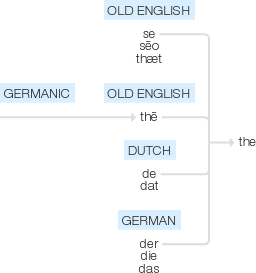The
Old English se, sēo, thæt, ultimately superseded by forms from Northumbrian and North Mercian thē, of Germanic origin; related to Dutch de, dat, and German der, die, das .
wiktionary
From Middle English the, from Old English þēm(“the, that”, demonstrative pronoun), a late variant of sē, the s- (which occurred in the masculine and feminine nominative singular only) having been replaced by the þ- from the oblique stem.
Originally masculine nominative, in Middle English it superseded all previous Old English nominative forms ( sēm, sēof, þætn, þāpl); sē is from Proto-West Germanic *siz, from Proto-Germanic *sa, ultimately from Proto-Indo-European *só.
Cognate with Saterland Frisian die(“the”), West Frisian de(“the”), Dutch de(“the”), German Low German de(“the”), German der(“the”), Danish de(“the”), Swedish de(“the”), Icelandic sá(“that”) within Germanic and with Sanskrit sá(“the, that”), Ancient Greek ὁ(ho, “the”), Tocharian B se(“this”) among other Indo-European languages [1].
From Middle English the, thy, thi, from Old English þȳ(“by that, after that, whereby”), originally the instrumental case of the demonstratives sē(masculine) and þæt(neuter). Cognate with Dutch des te ("the, the more"), German desto ("the, all the more"), Norwegian fordi ("because"), Icelandic því(“the; because”), Faroese tí, Swedish ty.
the
etymonline
the
definite article, late Old English þe, nominative masculine form of the demonstrative pronoun and adjective. After c.950, it replaced earlier se (masc.), seo (fem.), þæt (neuter), and probably represents se altered by the th- form which was used in all the masculine oblique cases.
Old English se is from PIE root *so- "this, that" (source also of Sanskrit sa, Avestan ha, Greek ho, he "the," Irish and Gaelic so "this"). For the þ- forms, see that. The s- forms were entirely superseded in English by mid-13c., excepting a slightly longer dialectal survival in Kent. Old English used 10 different words for "the," but did not distinguish "the" from "that." That survived for a time as a definite article before vowels (that one or that other).
Adverbial use in the more the merrier, the sooner the better, etc. is a relic of Old English þy, the instrumentive case of the neuter demonstrative (see that).
